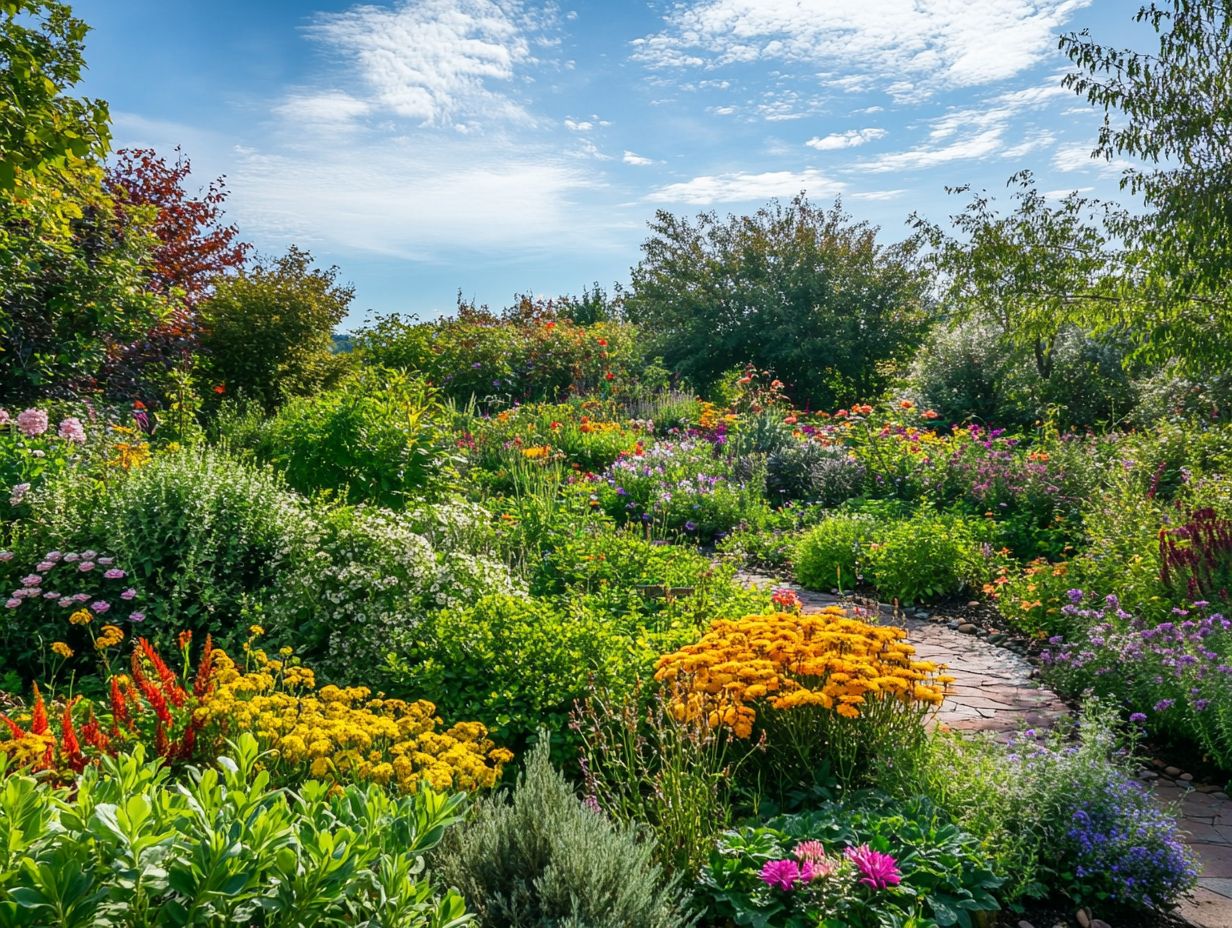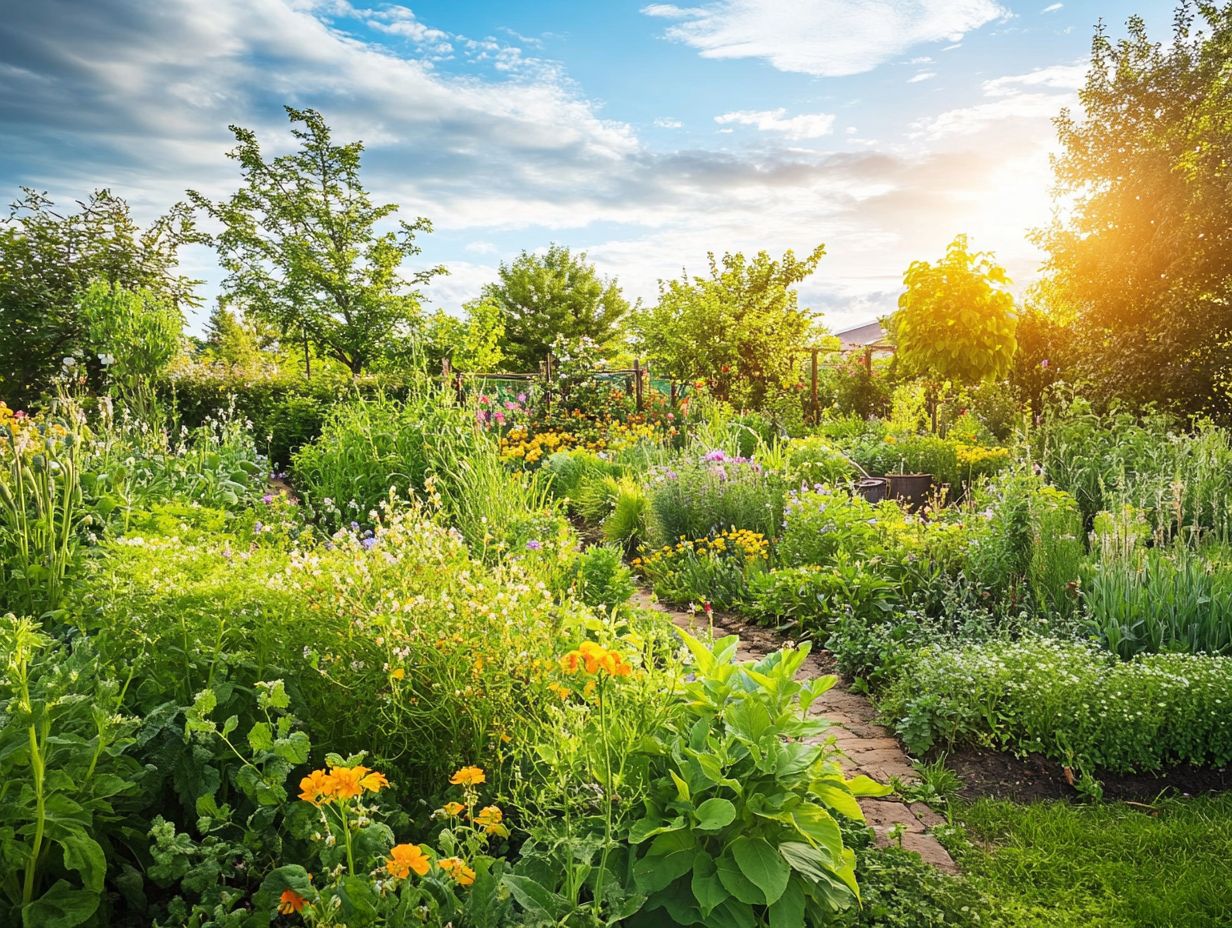The Benefits of Water-Resilient Plant Choice
Water-resilient plants are more than just a savvy choice for your gardening endeavors; they are vital for sustainable landscaping in today s ever-changing climate.
As you confront the challenges of increased water scarcity and unpredictable weather patterns, choosing the right plants can make a significant difference.
This article delves into the diverse array of water-resilient plants, from drought-tolerant varieties to those that flourish in wet conditions.
Uncover their environmental benefits, explore cost-saving opportunities, and gather practical tips for incorporating them into your garden, ensuring a lush and resilient landscape.
Contents
- Key Takeaways:
- The Importance of Water-Resilient Plants
- Types of Water-Resilient Plants
- Why You Need Water-Resilient Plants in Your Garden!
- How to Incorporate Water-Resilient Plants in Your Garden
- Frequently Asked Questions
- What are the benefits of choosing water-resilient plants for sustainable gardening?
- How do moisture retention strategies help conserve water with drought-resistant plants?
- Can water-efficient design thrive in all local climates?
- What are some examples of eco-friendly landscaping projects and permaculture?
- How do plant resilience and their aesthetic appeal benefit the environmental impact?
- Do water-wise gardening education and seasonal rainfall benefit gardening communities, pollinator habitats, and local wildlife?
Key Takeaways:

- Incorporating water-resilient plants in your garden can help conserve water through innovative water-saving strategies and save money on your water bill.
- Drought-tolerant and water-loving plants are both great options for a water-resilient garden and provide environmental benefits such as reducing erosion and improving air quality.
- When choosing water-resilient plants, consider your climate and soil conditions and follow proper planting and maintenance tips for a thriving, sustainable garden.
The Importance of Water-Resilient Plants
In today s ever-evolving climate, adding water-resilient plants to your outdoor spaces is vital. These amazing plants not only resist drought but also boost our environment.
Often native species, they are finely tuned to local climates and thrive with minimal irrigation. They support local wildlife and foster biodiversity within your ecosystem.
By selecting these plants, you can craft visually appealing landscapes that require less maintenance while championing sustainable gardening practices particularly in regions susceptible to drought.
Why Choose Water-Resilient Plants?
Choosing water-resilient plants is crucial for effective water management, especially in areas grappling with increased drought and climate variability.
These plants are your allies in reducing overall water consumption. They adapt seamlessly to their environment and thrive with minimal irrigation.
By incorporating water-efficient design principles, you can elevate your gardening experience, creating small areas with different weather conditions than the surrounding area that naturally retain moisture.
Using organic mulches serves as a protective barrier, preserving soil moisture and regulating temperature. This benefits not only your plants but also the surrounding ecosystem.
Educate your community about sustainable practices to foster shared responsibility toward the environment. This encourages a collective shift toward conservation.
By adopting these innovative gardening techniques, you can minimize reliance on chemical treatments, cultivating a healthier and more resilient landscape.
Types of Water-Resilient Plants
Understanding the various types of water-resilient plants is essential for crafting a garden design that harmonizes with local climates and conditions. By selecting drought-tolerant plants that conserve soil moisture alongside species that flourish in wetter environments, you can significantly bolster the resilience of your landscape.
Not only will this informed choice enhance the overall aesthetic appeal, but it will also create a welcoming habitat for local wildlife.
Drought-Tolerant Plants

Drought-tolerant plants are your go-to option for thriving in low-water conditions. They are an exceptional choice for eco-friendly landscaping and sustainable gardens.
By selecting these resilient species, you not only elevate the beauty of your outdoor spaces but also significantly reduce your overall water usage.
For example, succulents, native grasses, and certain perennial flowers require less frequent watering, allowing you to adopt a cost-effective and environmentally responsible gardening approach.
Beyond saving on water bills, these plants typically demand minimal maintenance, letting you enjoy their beauty without the hassle of constant upkeep.
Plus, many of them serve as vital habitats and food sources for local wildlife, fostering biodiversity and promoting a healthier ecosystem right where you live.
Start transforming your garden with water-resilient plants today!
Plants That Thrive in Wet Conditions
Get ready to transform your garden! Plants that flourish in wet conditions are essential for managing drainage issues and enhancing soil health. They are the perfect choice for rain gardens and other water-efficient designs that exemplify eco-friendly landscaping.
Species like Joe-Pye weed, cattail, and swamp milkweed thrive in saturated environments. They provide vital habitats for pollinators such as bees and butterflies. Incorporating these plants into your garden can significantly boost biodiversity while tackling soil erosion.
Creating clusters of these plants will stabilize the soil with their root systems and provide a sanctuary for wildlife, nurturing a vibrant ecosystem. Choose native varieties and ensure proper spacing to maximize their ecological benefits and elevate your green space to new heights.
Why You Need Water-Resilient Plants in Your Garden!
Incorporating water-resilient plants into your garden offers benefits that go well beyond mere aesthetics. These plants reduce maintenance efforts and lower your water bills, fostering sustainable gardening practices that are increasingly vital in today’s climate.
By supporting local wildlife and enhancing biodiversity, you create a thriving ecosystem. In our world of frequent droughts, these plants can make a significant difference.
Environmental Benefits
The environmental benefits of water-resilient plants are truly multifaceted. They influence everything from soil health to the biodiversity flourishing within your local ecosystem.
These remarkable plants enhance soil structure by boosting organic matter, which improves nutrient availability for other species. Thriving in various moisture conditions, their root systems work tirelessly to retain water, effectively preventing erosion and ensuring that the soil remains moist during dry spells.
This moisture retention sustains plant life and cultivates a thriving environment for microorganisms, fostering rich biodiversity that attracts diverse wildlife. By providing both shelter and food, these resilient species significantly contribute to sustainable habitats, maintaining ecological balance.
Cost Savings

One of the most enticing benefits of water-resilient plants is the significant cost savings they offer homeowners. You can reduce water usage and lower maintenance needs.
By opting for these drought-tolerant varieties (plants that can survive with little water), you can dramatically decrease your monthly water bills since these plants require less frequent irrigation. The diminished need for fertilizers and pesticides not only yields additional financial advantages but also nurtures healthier ecosystems.
Over time, embracing sustainable gardening practices leads to long-term economic savings while enhancing your commitment to environmental stewardship. You ll discover that investing in a water-conscious garden alleviates immediate expenses and contributes to the conservation of vital resources, creating a win-win scenario for both your budget and the planet.
How to Incorporate Water-Resilient Plants in Your Garden
Incorporating water-resilient plants into your garden design demands careful planning and an understanding of local climate conditions. This approach offers you the chance to craft stunning, sustainable outdoor spaces that flourish with minimal intervention.
Start planning your water-efficient garden now and help save our planet!
Tips for Planting and Maintenance
Successfully planting and maintaining water-resilient plants requires strategies that enhance soil moisture retention. These practices support sustainable gardening.
By employing techniques like hydrozoning, you can establish distinct planting zones tailored to the specific water needs of various plants, ensuring efficient moisture management. Incorporating organic mulches not only suppresses weeds but also regulates soil temperature and improves water retention by reducing evaporation.
Ongoing maintenance, like inspecting for pests and diseases, supports plant health and bolsters resilience. Watering deeply during cooler times of the day and selecting drought-tolerant species ensures your garden remains vibrant while nurturing a sustainable ecosystem that benefits both flora and fauna.
Frequently Asked Questions
What are the benefits of choosing water-resilient plants for sustainable gardening?

Water-resilient plants offer amazing benefits, including requiring less water, being more drought-resistant, and promoting soil conservation. They can also save you money on water bills and reduce the need for maintenance.
How do moisture retention strategies help conserve water with drought-resistant plants?
Drought-tolerant plants have adapted to survive with less water, which means they require less frequent watering. This helps conserve water, especially in areas with limited water resources or during times of drought.
Can water-efficient design thrive in all local climates?
Water-resilient plants can thrive in a variety of climates, from dry and arid regions to humid and rainy areas. However, it is important to choose plants that are well-suited to your specific climate for the best chances of success.
What are some examples of eco-friendly landscaping projects and permaculture?
Some common examples of drought-tolerant plants include succulents, cacti, lavender, rosemary, and yarrow. However, there are many native species available, so it is best to research which plants are best for your specific region and needs.
How do plant resilience and their aesthetic appeal benefit the environmental impact?
Water-resilient plants have deep root systems and organic matter that can help prevent erosion, improve soil health, and support biodiversity. They also require less fertilizer and pesticide use, reducing the amount of harmful chemicals in the environment.
Do water-wise gardening education and seasonal rainfall benefit gardening communities, pollinator habitats, and local wildlife?
Absolutely! Water-resilient plants are low-maintenance and require less frequent watering, which can save gardeners time and effort. They also tend to be more disease and pest-resistant, reducing the need for chemical treatments and organic mulches.






